This document contains the logs of the third singlehanded leg of the return trip with S/Y Thetis from the Greek Aegean island of Samos, to her base Glyfada, near Athens. The leg is from Sigri, Lesvos to Myrina, Limnos. The places seen on the way are: Moudros, Ormos Thanos, Hephaestia, Kavirio, Plaka, and Katalakkos. The logs are illustrated with maps and photographs, and also include some historical and geographical descriptions of the places visited as well as several links to other related web sites.
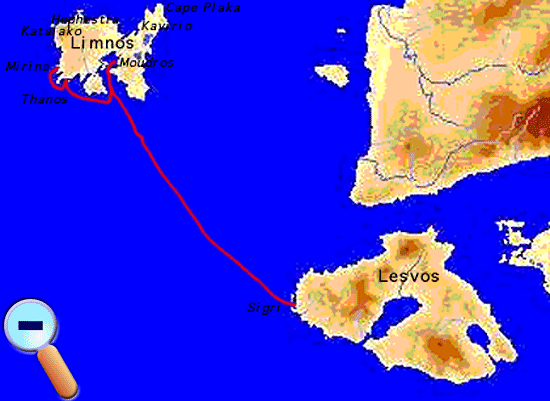
Wednesday September 9, 1998 Day 7
I was woken up by the alarm at 3:00 AM and had a cup of coffee. Since I already had raised and lashed the zodiac, I was ready to pull up the anchor and leave. It was not so easy! The starter did not work. I already had some difficulties with the starter before (since last year). During the winter, I had the electrician replace the starter button, as a precaution, and most of the summer it did not give any trouble. Last month, however, it had some difficulties. I attributed them to the aging starting battery not holding its charge, and indeed after switching in the house battery bank the starter worked. But today, at this early hour, neither bank would activate the starter solenoid. I checked the solenoid’s fuse and it was OK, the contacts did not look corroded but I cleaned them anyway, still no go. As I did not want to lose much time, I jumped the solenoid, and started the engine.
With all this trouble, we were not on our way until 0420. Exiting the Sigri area at night, with the Meganisi island and the various reefs, was a hair-raising experience. Had I not had the GPS and the radar and, even more helpful, the moon, I would not had even attempted this night departure. Anyway, by the time we motored past these obstacles there was a good 15 knot NNE breeze. I raised the main (no reefs) and unrolled half of the genoa. It was a good close-hauled sail and I turned off the motor. After 15 miles, the wind strengthened and I reduced the main to the 1st reef and also rolled-in more of the genoa. This good sail lasted all the way to the entrance of the Moudros Bay of Limnos. We crossed paths with many freighters and container ships either coming or going to the Dardanelles. One of them came closer than 1 M but as I knew her distance from the radar, I did not change course.
After entering Moudros Bay, I lowered the sails and motored the passage to the inner bay which is long, dangerous, and full of reefs. The bay is impressive in its size but its water is green and murky. There was a lot of chop everywhere. I anchored at Euriance Cove [39° 52' N 25° 15.4' E], which seemed the best choice. It was 1410 and we had covered the 55.4 M from Sigri, Lesvos in 9.8 hours.
Limnos (Λήμνος) is a low lying island of 477 km² with 16,000 inhabitants. The tallest peak of Skopia is only 430 m above sea level. Being strategically located at the entrance of the Dardanelles, Limnos has had a long history.
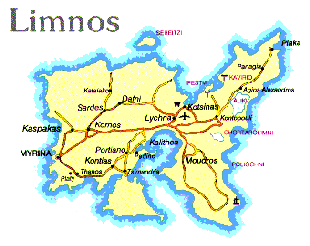
According to mythology, the metal smith god of fire, Hephaestos, had his workshop in Limnos. It was also here that he had his honeymoon when he wedded the beautiful goddess of love Aphrodite. Shortly after the wedding, she was unfaithful to him. Hephaestos accused her of her infidelity to Zeus and called as his witnesses the women of Limnos. The goddess, angered by this, had her revenge by making the Limnian women totally unattractive to their husbands. The women, in their turn, rebelled against the men and butchered them, all except Thoas who was saved by his daughter Hypsilpyle who became the queen of the island. When the Argonauts stopped in Limnos on their way to Colchis, they had affairs with the man-starved ladies and the island was re-populated.
The first known inhabitants of Limnos were the Pelasgians (a Pelasgian inscription has been found from that era which has not been deciphered). Before the Persian Wars the Athenian Miltiades, the future victor of Marathon (490 BC), drove the local inhabitants off and re-populated the island with Athenians. The island changed hands many times and fell under the Macedonians and later under the Romans. It then became part of the Byzantine Empire until 1204 AD. After that time it alternated between the Genoese and the Venetians. The Ottomans took the island in 1478, it was re-occupied by the Venetians in 1656, and it fell back again to the Ottomans, who held it until 1920 when it became part of Greece with the town of Myrina as its capital.
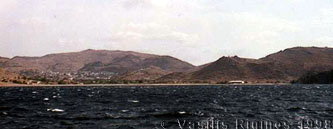
The Bay of Moudros (Κόλπος Μούδρος) is one of the largest natural harbors in the Mediterranean. During the Gallipoli campaign of World War I it was the anchorage of the Allied Fleet. Today, there is a large military presence mostly based at the large airfield adjacent to the bay.
I was actually rather disappointed with Moudros Bay. While Thetis was safe, the bay was neither pleasant nor comfortable because of the chop and the murky water. I made myself some lunch, as I was very hungry, and then called Alice over the Autolink. There was no answer so I recorded a message. I also called my brother Nikos asking me to send me the C-Map cartridge for the Sporades islands (we own this cartridge jointly). As I did not think that it would be possible for me to go ashore with the zodiac without getting drenched, and not being very comfortable, I had a cup off coffee and raised the anchor.
We left Moudros at 1600 heading towards Koudros. Again, it was not so sheltered, despite the good write-up in both pilot books. I checked the nearby cove of Agios Pavlos, and finally settled at the Ormos Thanos (Όρμος Θάνος), which turned out to be the very spot in which we had anchored for an overnight in 1992.
We anchored at Ormos Thanos [39° 50.4' N 25° 04.7' E] at 1905 having gone 16 M from Moudros. It is a very attractive cove despite the gusts. The sea was calm. Unfortunately, the restaurant ashore where we had such a good meal in 1992 was shut. I was very tired. The sky today had light clouds, almost overcast, and it was not too hot, only 25°C. Now thicker clouds were rolling in and the temperature had dropped to 21°C. The Navtex forecast called for a force 6-7 ENE wind increasing overnight. Sure enough, while I was cooking my supper, the wind increased. As I was tired, I went to bed around 9:30.
The wind was howling all night with gusts over 35 knots. Fortunately I had 50 m of chain with the anchor dropped in sand at a depth of 5 m and plenty of swinging room. During the night, the wind generator which had been totally passive for the past few weeks, woke up and started roaring like a 747 taking off. There was not a single miliampere produced to go along with this noise. This time the generator did not respond to its switch (it is supposed to stop when its leads are shortened) and kept on roaring, making it impossible to sleep. So, I got up, half asleep, and tried to stop it by attempting to tie its rotor with a rope. I ended up breaking off two of its three expensive blades. I will have to take the wind generator back to the US for repairs. It worked well, if noisily, for its first year but in the past two years it has been an albatross.
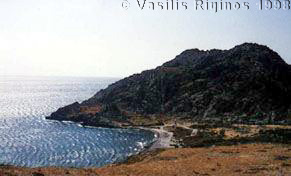
Thursday September 10, 1998 Day 8
Overnight, the wind increased to an average of 35 knots with gusts as high as 48 knots. Indeed, the Navtex was now issuing a gale warning for this area. I decided that while, for the time being, we are safe here, there was neither a reason nor it was pleasant to stay here and be battered by the violent gusts. So I deceided to go to the main harbor of Myrina. There was no need for any departure preparations because I had not launched the zodiac, as it was totally useless with last evening’s wind. Raising the anchor presented a problem. The gusts, coming from the land, were so strong that the windlass could not pull Thetis against them. I had to use the autopilot to hold the tiller in place while engaging the engine at a slow forward speed, to ease the load on the windlass, while I, on the bow, slowly raised the anchor.
We left Ormos Thanos at 0930 and motored against the violent wind for the 6.7 M to Myrina. In the meantime, the Navtex had upgraded the gale to a “strong gale” with winds of force 8-9! We arrived at Myrina (Μύρινα) [39° 52.3' N 25° 03.3' E] at 1105, after a very unpleasant 1:35 hour. But our problems were far from over. The wind was so strong that it was impossible to prepare the docking lines and the fenders outside the harbor. Inside the harbor, while calm, the wind was not less violent. To prepare the boat, I kept her moving forward under the autopilot while I tied fenders and lines. Since the harbor is not very large, and since I had to keep some speed to avoid being blown off, I could do this only for a short time. Then, I had to manually change course and continue. This took some frustrating time. Finally, when we were ready to dock, I guided the boat to the position I had chosen to place the anchor, put her in reverse, and ran to the bow to drop the anchor while she lost her forward speed. However, by the time I dropped the anchor, and regained control of the boat in reverse the wind had blown us off the intended course and we could not proceed to complete the maneuver. After several frustrating attempts, I managed to drop the anchor where I wanted and let go of enough chain for the anchor to bite. But approaching the quay was another matter. I could only pay out the chain via the windlass remote control from the cockpit. This was too slow to compensate for the over 40 knot gusts. After my third attempt, the skipper of a 50 ft sailboat took pity of me and offered to come aboard Thetis and handle the anchor from the bow while I maneuvered from the cockpit. I raised the anchor for the fourth time, and approached the pier while he stepped aboard. With the two of us this time, we had no problem anchoring and backing up to the quay, after letting 50 m of chain and an extra 15 of rope, where several of his crew mates were ready to catch the docking lines that at I heaved ashore. After Thetis was tied and I deployed the passarella, I also put 2 spring lines, shock absorbers, etc. We were secure. It was almost 1:00 PM!
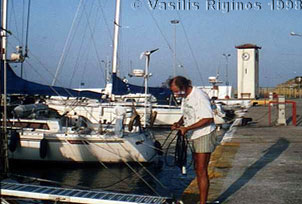
The total distance we covered from Sigri, Lesvos to Myrina was 78.1 M, and the total time of travel was 14.5 hours.
The nice skipper who helped me, Lefteris, is a professional skipper and operates out of Kalamaki. After talking, we both realized that we know quite a few people in common. He not only knows my brother Nikos but actually had seen him with the Faneromeni only a few weeks ago in Poros. He is now skippering the S/Y John-Anna which is right next to Thetis. The harbor, in addition to water, also provides electricity. I believe this is the first time that Thetis was connected to shore power in a Greek port apart from her marina in Glyfada.
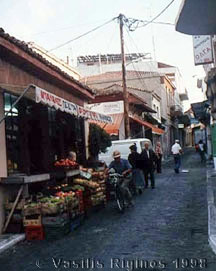
I went ashore and walked the streets of the charming town. I bought some fresh bread for lunch. I also called Rozina; she has gotten the C-Map cartridge from Nikos, and had already sent it to me here by express mail. I should have it tomorrow. I also called Alice, and I actually found her and we had a long talk.
Near Thetis there was the British sailboat Rubitoo with a middle aged couple aboard. They have just come from Çanakkale after spending two months in the Black Sea. They went to Bulgaria, Ukraine (Yalta and Sevastopol), and across to the Turkish shore and on to Trabzon. They have had a wonderful time, despite the water which was not very clean. They loved the sights, especially Varna in Bulgaria. They gave me all their used charts of the region, a real bonanza.
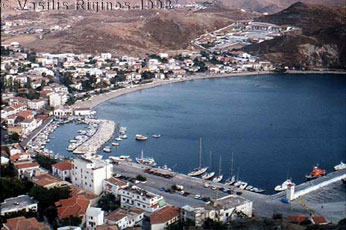
Later in the afternoon I walked up to the castle. There was a large herd of roe-deer (ζαρκάδια), which were free roaming in the castle grounds. They were really beautiful. I was told that they are native to Limnos and are now protected. The castle, which is quite large in area, is Byzantine. It was built by the emperor Andronikos Komnenos in 1186 AD.
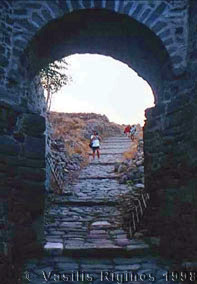
Myrina Castle |
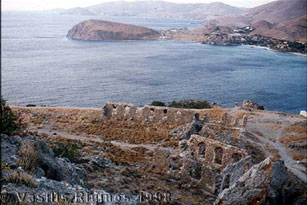
Northern view from the Castle |
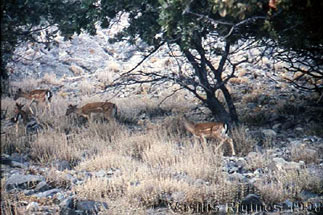
I located a laundry in town and gave them a load of clothes. Also a fuel truck came and delivered fuel to John-Anna, and I took advantage of its presence to top Thetis’ tanks with 61 L of fuel, thus avoiding the dreary jerry can routine.
After I returned to Thetis, Lefteris, the skipper of John-Anna, came to invite me for dinner on behalf of her Greek-American owner Louis Argyris. Louis was born in the US, and is now living in Philadelphia, where he is engaged in various business enterprises. He seems to own a number of boats is the US. He and his young wife Carol have owned John-Anna for a couple of years and they cruise for a month or two in the summer. Last year they were in Sardinia. Louis also likes to cruise with plenty of spirited company. In addition to Carol and Lefteris there are several young people aboard making their total of 9. We had a very pleasant evening, with conversation and plenty of wine, while John-Anna was rocked by the 48 knot gusts.
The Navtex forecast for tomorrow is gale with force 8 winds in the East Aegean. Lefteris and I were informed by the Limenarchio (Coast Guard) that our boats were docked at the exact spot where the small ferry from Agios Evstratios docks. Should the ferry come tomorrow, which they highly doubted because of the gale, we would have to relocate.
Friday September 11, 1998 Day 9
Once again, all night the wind was howling and the boat was shaking, but the anchor held. In the morning the wind was around 32 knots with higher gusts. Lefteris came and told me that the ferry is definitely not coming and we do not have to move.
I went to the Post Office and got the package from Rozina. Alas, it had the wrong C-Map cartridge. The West Sporades (Skiathos, Skopelos, Skyros) are commonly referred to by the Greeks as simple the Sporades. The cartridge I wanted Nikos to send was for them, so I asked him for the Sporades cartridge. What he gave to Rozina was labeled “Sporades to Antalya” which covers the Dodecanese (I suppose they meant East Sporades). I was furious because I already have this cartridge, and being Friday, even with the best of efforts by Nikos and Rozina I could not get the right one before next week - the Greek Post Office does not work on Saturdays and Sundays. I called Rozina and left a message asking her to please contact Nikos and have him send me the desired cartridge.
To console myself, I rented a motorbike to explore the island. First, I went to the museum. While it is not a very large museum, it is a model of what a museum should be. It is housed in a restored neoclassical building and kept meticulously clean. The exhibits are attractively presented in modern, well lit, cases. Each exhibit is numbered and on the wall there are explanatory labels in 3 different languages corresponding to the exhibit numbers. The only disappointment was that a number of interesting objects had been removed to the National Museum in Athens and only their photographs are shown here.
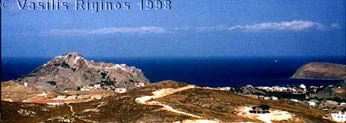
After the visit to the museum, I packed some water, took the camera, and rode the bike toward Moudros, taking a road that drove right over the cove Thanos where I had spent the first night in Limnos. The island is very lovely with its reddish brown landscapes. I followed a small road along the W bank of Moudros Bay until it joined with the main highway, past the large military airport. Near the town of Moudros I took a small road leading to the NE side of the island. At the village of Kontouli (Κοντούλι), I turned to the rough dirt road that leads to the site of ancient Hephaestia (Ηφαιστία). This is the location of the classical city dedicated to Hephaestos. To the E of the site there is a very good harbor, used in the antiquity, but today its entrance is silted and the waters are brackish. The site has been excavated by the Italians and the Greeks, who have discovered a sanctuary believed to be of the Great Goddess, same as the one worshipped at Samothraki, a palace, and a small theater. The view from the hill toward the angry north sea is wonderful. As I was getting ready to leave, the whole crew from the S/Y John-Anna spilled out of two cars and with Lefteris at the lead, started climbing toward the site.
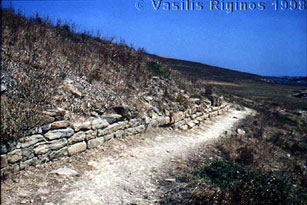
Wall |
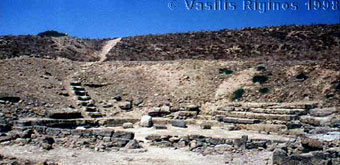
Theater |
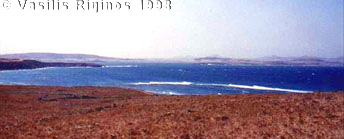
View to N |
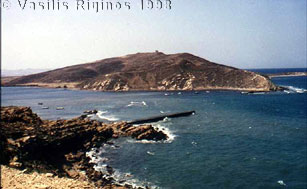
The harbor |
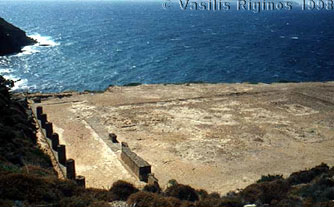
The next place that I wanted to visit, was the Kavirio (Καβείριο) site. I started in that direction at 2:00, despite the fact that the guard at Hephaestia had told me that they close at 2:30. By the time I got there, after getting lost a few times in the dirt roads it was past 3:00 and the site was indeed closed. But, being at heart a naughty boy, instead of missing the site, I climbed over the gate and walked to the site. This was a Hellenistic temple dedicated to the Kaviroi or Cabiroi. Their origin is rather obscure, they are associated with the Great Gods worshipped in Samothraki, or, according to a later source they are the offspring of Hephaestos. At any rate their site is very imposing, overlooking the angry sea.
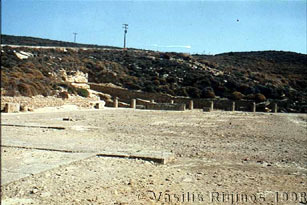
The Temple |
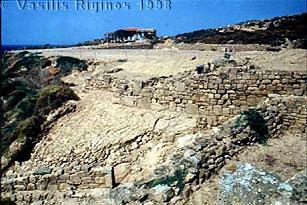
The wall |
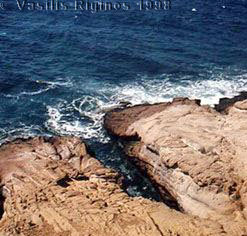
I also saw, next to the Kavirio site, the “cave of Philoctetes.” Philoctetes was a member of the expedition to Troy. He was bitten by a snake in Tenedos and his wound festered. The rest of his mates, not being able to withstand the smell of the wound, abandoned him in Limnos where he lived in a cave and subsisted on game that he hunted with his bow which had belonged to Herakles (Hercules).
I then drove to Plaka (Πλάκα), the easternmost village of Limnos. Once again, I bumped to the crew S/Y John-Anna, this time eating at a restaurant. They too, after their visit to Hephaestia, went to the Kavirio but they found it closed. So, they repaired to a restaurant. I had a beer with them, and then following their advice, I took a back road route back to Myrina.
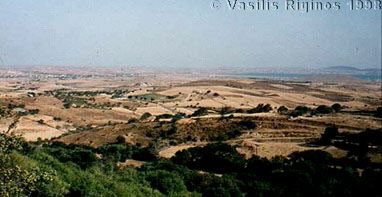
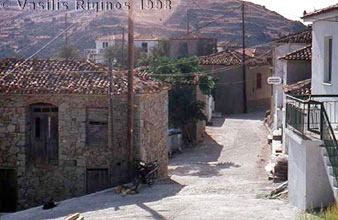
I went to Atsiki (Ατσική), where I turned into a dirt road leading to Daphni (Δάφνη) and eventually to the picturesque village of Katalakkos (Κατάλακκος). From Katalakkos I descended to the main road leading to Myrina. This was a very lovely ride. I passed by several vineyards being harvested (τρύγος), the smell of the fermenting grapes was almost overpowering. On one of the slopes, there was a beautiful young shepherdess, with very long black hair, playing a flute. If I were not on a motorbike, I could easily believe that I was seeing Chloe. I passed a canyon full of fragrant myrtle bushes. As it was a windy early autumn day, the atmosphere was very clear, and everything had assumed a most vivid color.
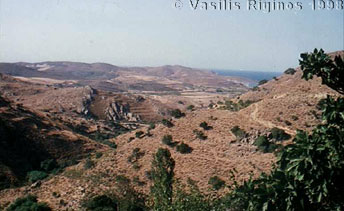
By the time I got back to Thetis, the wind was appreciably down and the sea, at least in the harbor, was very flat with hardly any wrinkles. I had a cup of much needed coffee and then I took advantage of the motorbike to go to an out-of-town supermarket to exchange the spent camping gaz canister for a full one. After unloading the canister, I returned the motorbike and walked to the boat for a very welcome hot shower.
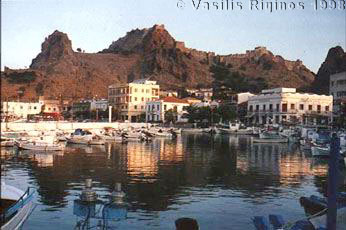
I picked up my laundry and walked around the old fishing boat harbor with its many restaurants, trying to decide where to go later for dinner. I then bought a few bottles of Limnos wine and ouzo, which are excellent, and some local cheese, and grapes, also delicious. I am all set for sailing early before the arrival of the Agios Efstratios ferry.
I had a most pleasant dinner at the Glaros restaurant consisting of a salad, grilled shrimps, and swordfish with plenty of Limnian wine. The view of the fishing harbor, reflecting the illuminated castle, combined with the great food and the wine, made for a very special evening.
When I returned to the boat, I found that the chartered yacht to the right of Thetis, with 11 Germans, was about to leave. This caused some anxiety on my part, shared with Lefteris on John-Anna, that they might dislodge our anchors. Sure enough both Thetis’ and John-Anna’s chains were over theirs. I loosened mine and so did Lefteris and the Germans managed to leave without any mishap.
The latest printout from the Navtex predicted, for tonight, 5-6 ENE winds turning to WSW of the same strength by the morning. Here, the wind was a “calm” 26-28 knot from the NNE. It is a nice calm night.